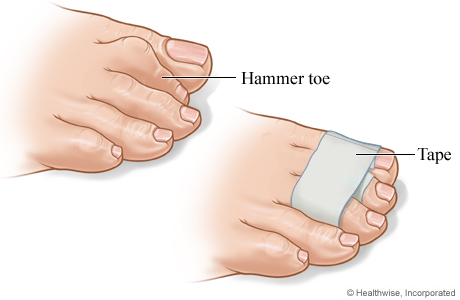How is a Hammer Toe Diagnosed?
DiagnosisDoctors can typically diagnose a hammer toe through a physical exam. They will determine how rigid the toe joint has become before recommending a course of treatment. Imaging tests, such as an X-ray, may be needed in order to rule out injury to a bone, ligament, or muscle in the toe.
How is a Hammer Toe Treated?
TreatmentsTreatments for hammer toe vary depending on the severity of the case—ranging from nonsurgical to surgical options.
Treatment for mild hammer toe
Options for fixing a hammer toe can depend on your pain level and toe joint rigidity. For most mild cases of hammer toe, in which the joint maintains good flexibility, treatment options can include:
- Proper footwear - Ditch your high heels for lower heels. Wear shoes with a wider toe box made of flexible material. Consider sandals, as long as the strap doesn’t rub against the affected toe.
- Toe stretches and exercises - Scrunching and splaying your toes can help flexibility. Picking up a towel or a marble with your toes can strengthen and stretch the toe muscles.
- Shoe pads or inserts (orthotics) - Redistributing the weight of your foot can take pressure off the toe joint and alleviate pain
- Taping the toe - Securing the affected toe can shift muscular imbalance
- Pain relief - Over-the-counter anti-inflammatories or cortisone shots can help with pain and swelling
Treatment for severe hammer toe
If you’ve tried all the recommended nonsurgical options and the pain is still impeding your everyday life, hammer toe surgery may be required. The type of surgical procedure used for hammer toe surgery depends on the severity of the deformity and could involve:
- Inserting a pin to realign your toe’s position
- Removing a piece of bone to straighten the toe
- Tendon lengthening to elongate the affected toe tendon and encourage healthy alignment
- Tendon transfer, in which tendons from the bottom of the toe are transferred to the top, pulling the joint into a straighter position
Surgery for a hammer toe is typically an outpatient procedure. Recovery time can be between 4-6 weeks, with expected redness, swelling, and stiffness at the procedure site.
Trust NewYork-Presbyterian for Hammer Toe Care
At NewYork-Presbyterian Columbia Orthopedics, our foot and ankle specialists are well-versed in treating a wide range of orthopedic conditions, including hammer toe. We utilize state-of-the-art imaging technology combined with a physical examination to determine the symptoms and causes of your pain. We’ll work with you to explore all nonsurgical options and, if necessary, provide surgical solutions.
You don’t have to live with the pain. Contact NewYork-Presbyterian today for relief from your hammer toe symptoms.




